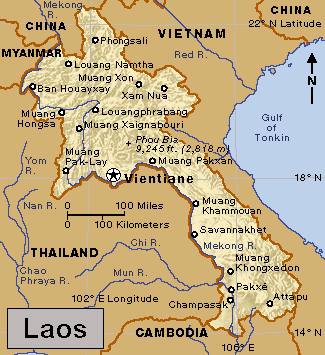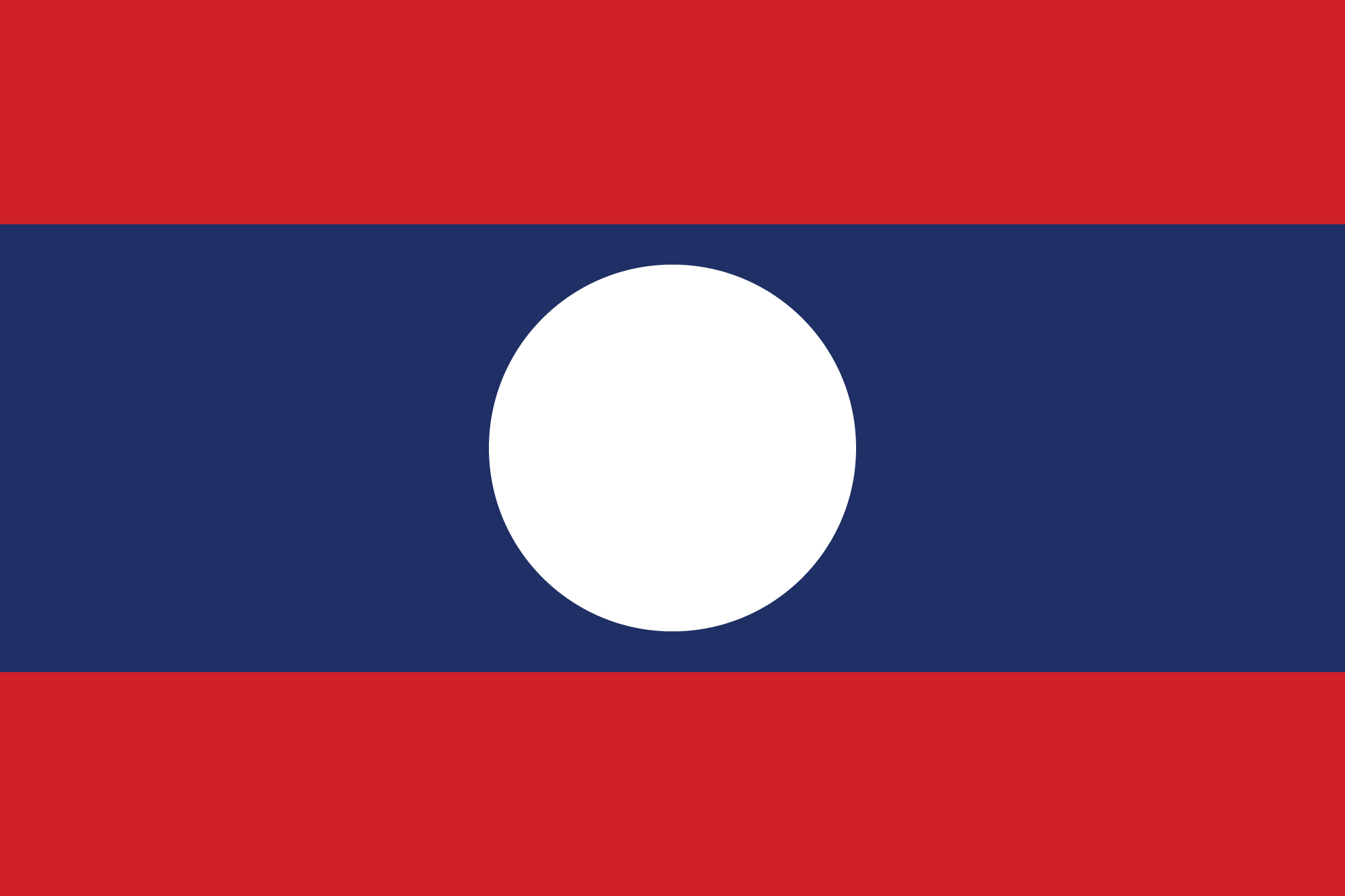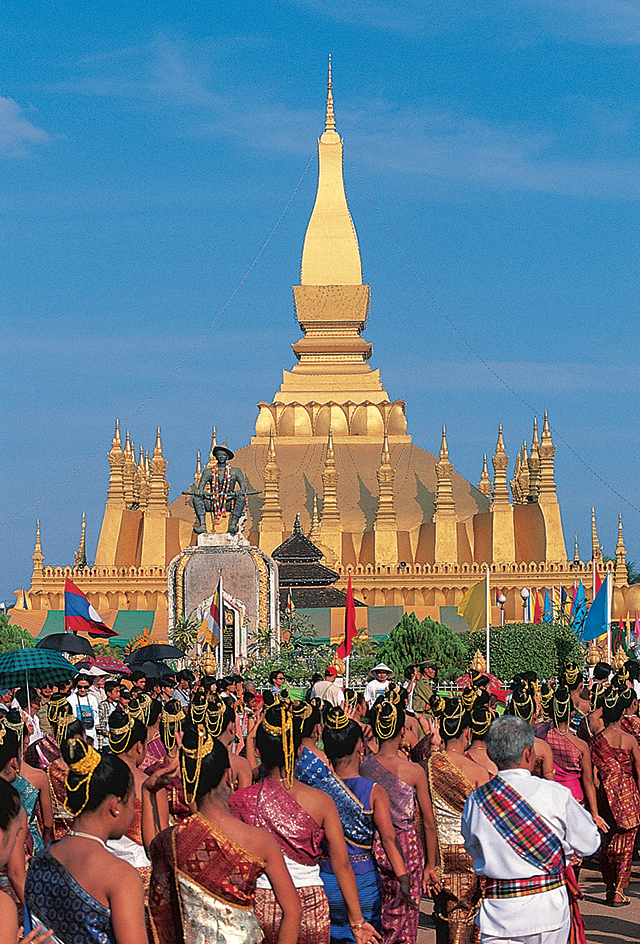Laos << LAH ohs >> is a landlocked country in Southeast Asia. It is bordered by China to the north, Vietnam to the east, Cambodia to the south, and Thailand and Myanmar to the west. Much of Laos is mountainous, especially in the north and east. Most of the western border is formed by the Mekong River. The official name of Laos is the Lao People’s Democratic Republic. Vientiane is the nation’s capital and largest city.

Laos has many ethnic groups. The ethnic Lao make up a majority of the population, and the country is named after them. Most ethnic Lao live in the country’s lowland plains and valleys.
Laos came under French authority in the late 1800’s. It regained full independence in 1953. The Communist Pathet Lao movement has controlled the government since it seized power in 1975.
Government.
Laos is governed by a single party, the Lao People’s Revolutionary Party (LPRP). The leaders of the party’s Political Bureau and Central Committee are the most powerful officials in the country.

The National Assembly is Laos’s legislative body. The people elect its members to five-year terms. All Assembly candidates must be approved by the LPRP. The Assembly elects the president of Laos to a five-year term. The president serves as head of state. The president, with the approval of the Assembly, appoints a cabinet and a prime minister, who serves as head of the government. The Supreme People’s Court is the highest court.
People.
More than 50 ethnic groups live in Laos. They are officially divided into three broad categories: (1) the Lao Lum, (2) the Lao Thoeng, and (3) the Lao Sung.

Laotian folk dance
The Lao Lum—that is, the Lao of the lowlands—include the ethnic Lao, as well as the Lu, Phuan, and various upland Tai tribes. The Lao Lum speak Tai languages, including Lao, which is the official language of Laos. Most Lao Lum live in villages of 40 to 50 households. Their houses are typically built above the ground on wooden posts. Most Lao Lum are Buddhists, and the wat (temple) is the social center of the village. They grow rice on irrigated paddies. Their main food is glutinous (sticky) rice eaten with chopped meat or fish and vegetables.
The Lao Thoeng—the Lao of the mountain slopes—speak Mon-Khmer languages. They grow rice by using slash-and-burn cultivation in which trees are chopped and burned to make way for farmland. Chief groups of the Lao Thoeng include the Khmu and Lamet in northern Laos and the Alak, Laven, and Oy in the south. Most Lao Thoeng are animists who worship a variety of nature spirits and carry out animal sacrifices.
The Lao Sung—the Lao of the mountaintops—live in northern Laos. They speak Tibeto-Burman or Hmong-Mien languages. Most follow animistic religions. The main ethnic groups of the Lao Sung include the Hmong and the Yao (also known as the Iu Mien). The Hmong raise most of Laos’s opium poppies, from which illegal heroin is made.
The vast majority of the people of Laos live in rural areas. Most villagers are poor. But as the population expands, more Laotians are moving to towns along the Mekong River. There, they find employment and better education and health services for their children.
Most of the Laotian people 15 years of age or older can read and write. Most Laotians attend elementary school, which lasts five years. Some attend a further six years of secondary school. The National University of Laos in Vientiane is the only university.
Land and climate.
Rugged mountains rise in northern Laos, and the Annamite Range extends along the border with Vietnam to the east. Phou Bia (Mount Bia) is the country’s highest peak. It rises 9,245 feet (2,818 meters) in central Laos. The Mekong is the country’s largest river.
Laos has three high plateaus. They are the Plain of Jars in the north, the Khammouan Plateau in central Laos, and the Bolovens Plateau in the south. Forests on the plateaus have largely been cleared for agriculture, but trees still cover much of the mountains.
Rainfall in much of Laos averages about 70 inches (180 centimeters) a year, but rainfall on the Bolovens Plateau averages about twice that amount. The rainy season lasts from May to October. Temperatures can reach 104 °F (40 °C) at the end of the dry season in March and April but can fall below freezing in the mountains in winter.
Economy.
Laos has little industrial development, and the country is one of the poorest in Southeast Asia. Following the Communist takeover in 1975, the government tightly controlled the economy. Since the late 1980’s, however, the authorities have relaxed their hold on the economy and encouraged private enterprise and foreign investment. 
A majority of Laotian workers are farmers. Most own small farms on which they grow rice. Some farmers also raise cattle, hogs, poultry, and water buffaloes. Leading crops include coffee, corn, and vegetables.
Laos’s forests provide rattan, teak, and other products. Small amounts of coal, copper, gold, gypsum, rock salt, and silver are mined in Laos. Most trade is with neighboring states, especially Thailand. Laos sells most of the hydroelectric power that it produces to Thailand.
Laos has few roads, and most of them are unpaved. Louangphrabang, Pakxé, and Vientiane have international airports. The government controls newspapers, radio, and television.
History.
A highly developed culture arose on the Plain of Jars about 500 B.C. The people of this culture carved huge stone jars that archaeologists believe were used in funeral practices.
Small groups of Tai people probably began to move into the northern part of Southeast Asia from about the A.D. 700’s. Lao warriors may have established a small principality (territory ruled by a prince) near Louangphrabang as early as the 900’s. Other Lao settlers pushed farther south. In the early 1200’s, small kingdoms that had been established on the middle Mekong started fell under the rule of the Khmer (Cambodian) empire.
In 1353, a Lao prince named Fa Ngum unified several Lao principalities into the kingdom of Lan Xang. In the early 1700’s, a succession dispute divided Lan Xang into three kingdoms. By the early 1800’s, all three had come under the control of Siam (now Thailand). At the end of the 1800’s, France incorporated nearly all of present-day Laos into its Indochina empire. It acquired control of the rest by 1907. A large part of the former kingdom of Lan Xang remained under Siamese control.
Laos was briefly occupied by Japan during World War II (1939-1945). After the Japanese surrendered in 1945, Lao nationalists who were part of the Free Laos movement seized power. But the French regained control in 1946. Independence within the French Union, as the Kingdom of Laos, came in 1949. Laos gained complete independence in 1953. Meanwhile, the Free Laos movement had split into several factions. In northeastern Laos, Souphanouvong, the leader of one of the factions, set up the Communist-inspired Pathet Lao movement.
The Geneva Accords of 1954 left the two northeastern provinces of Laos under Pathet Lao control. The rest of the country was ruled by the Royal Lao Government (RLG) with Souvanna Phouma as prime minister. In 1957, Souvanna Phouma and Souphanouvong formed a coalition government and reunited the country under RLG administration. The coalition collapsed, however, and in 1959, Laos plunged into civil war. A second coalition government was agreed upon in 1962. But that government also failed, and in 1963, government and Pathet Lao forces resumed fighting each other. By then, the Vietnam War had also begun.
The Vietnam War was fought between Communist-ruled North Vietnam and Communist-trained South Vietnamese rebels on one side and South Vietnam and the United States on the other. Laos tried to remain neutral during the war but was increasingly drawn into the conflict in the early 1960’s. From the mid-1960’s until 1973, U.S. warplanes heavily bombed sections of Laos, particularly the Ho Chi Minh Trail in the eastern part of the country. North Vietnam used the Ho Chi Minh Trail to move supplies and troops through Laos and into South Vietnam. Also during the war, the United States Central Intelligence Agency (CIA) recruited and trained a “secret army” in Laos to fight the Communists. This army was drawn mainly from the Hmong. Following the North Vietnamese victory in Vietnam in April 1975, thousands of Hmong and other Laotians fled Laos.
In December 1975, the Pathet Lao finally gained power and abolished the monarchy. At first, the government seized ownership of farms and factories and persecuted Buddhists. But as peasants mounted opposition to the government’s agricultural policy and people continued to visit Buddhist temples, the regime changed course. Beginning in the mid-1980’s, the government introduced an economic policy that encouraged foreign investment and returned farms and some industries to private ownership. In 1997, Laos joined the Association of Southeast Asian Nations (ASEAN), a regional organization that promotes economic, cultural, and social cooperation among its members.
